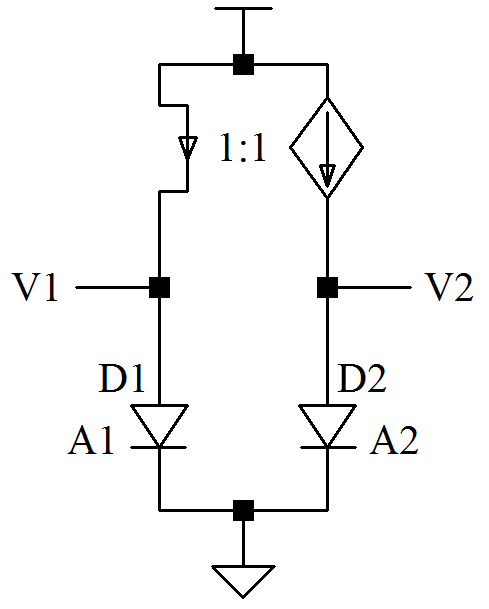Proportional-To-Absolute-Temperature
“Absolute temperature” being degrees Kelvin. Conveniently, degrees Celsius/Centigrade overlaps the Kelvin scale with identical magnitude: 1K = 1oC
I have elsewhere presented the diode equation as:
![]()
and demonstrated that the “minus 1” term may usually be neglected. Doing so, I can write the diode equation as:
![]()
The parameter “n” is often assumed a value of “1” although a value of 1.3 may be a better approximation. I won’t concern myself with that at the moment …
The concept of “thermal voltage” will appear fairly often and is defined:
![]()
Note: The temperature parameter in SPICE is used as the junction temperature. I often define T at 40oC: equal to 313K or 104oF. If defining in kelvin, I use 315K. These are more likely junction temperatures for an active network in idle state. YMMV of course.
I want to examine the term ![]() . Known as the “saturation” current in the SPICE model and sometimes expressed as
. Known as the “saturation” current in the SPICE model and sometimes expressed as ![]() , the term may be expressed in terms of current density:
, the term may be expressed in terms of current density: ![]() , where
, where ![]() is the current density through the junction and
is the current density through the junction and ![]() is the effective area through which the current flows.
is the effective area through which the current flows.
Consider this network:

Two matching diodes built on the same process in parallel branches with identical junction currents (via the ideal P-polarity current mirror) and at equal temperature.

Taking the difference in voltages …
![Rendered by QuickLaTeX.com \begin{displaymath}V_1 \, - \, V_2 \; = \; V_T \left[ \, ln \left( \frac{I_D}{\, J_s \,} \right) \; - \; log \left( \frac{I_D}{\, J_s \, A \,} \right) \, \right] \; \; = \; \; V_T \left[ \, ln \frac{\left( \frac{I_D}{\, J_s \,} \right)}{ \, \left( \frac{I_D}{\, J_s \, A \,} \right) \, } \right]\end{displaymath}](https://davemcglone.com/wp-content/ql-cache/quicklatex.com-a090b6803a00e4658edacc76574a3f92_l3.png)
or:
![]()
A voltage linearly proportional to temperature T (assuming effective
In developing “matching” components of different sizes, it is often useful to define a “unit” component and build arrays of identical pieces. For example, if I were to build a 3![]() 3 array of diodes, I could easily develop a 1:8 relationship of junction areas. The voltage difference would then be:
3 array of diodes, I could easily develop a 1:8 relationship of junction areas. The voltage difference would then be:
![]()
The effective temperature coefficient:
![]()
The primary errors would be due to mismatches in branch currents, leakage currents, and device matching.
A companion article may be read here: pn-Junction Temperature Coefficient
That’s good for now.
